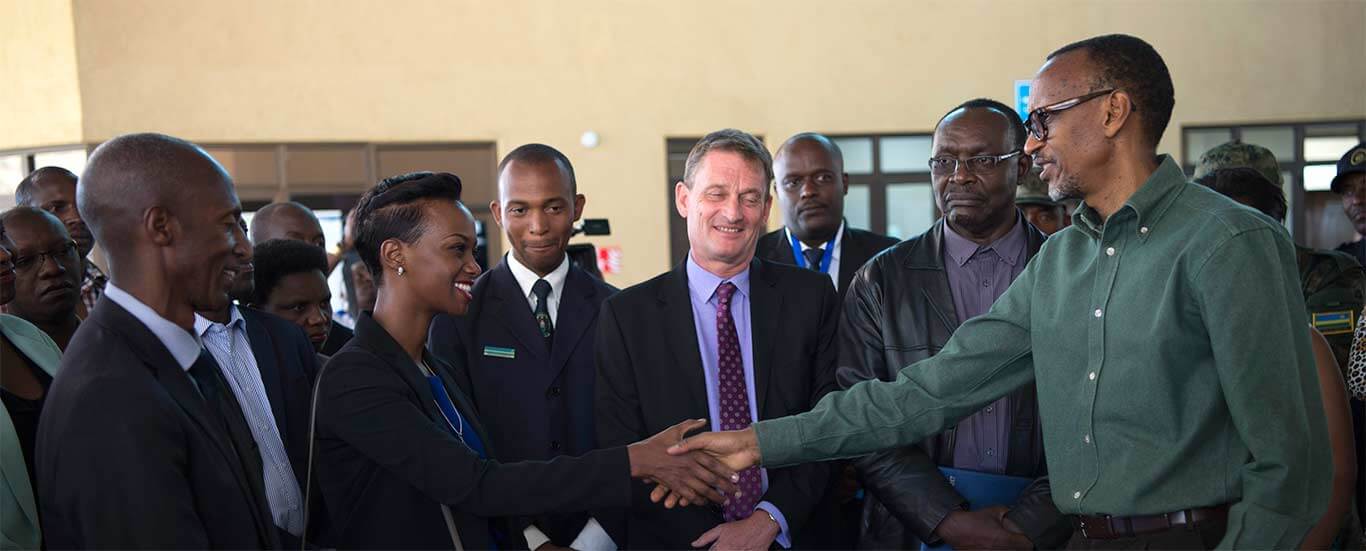- US $11.3 million invested in the construction of Kagitumba One-Stop Border Post (OSBP) facilities which includes Customs and Migration block, Inspection and Warehouse block, sheltered parking yards, internal roads
- TradeMark Africa funded the construction with support from UKAID and the Government of Canada.
- An Integrated Border Management System including computers and their accessories, internet, CCTV cameras, laboratory equipment, and development of OSBP procedures enables One Stop Controls.
- Construction started in May 2013 and operations officially commenced in December 2015. Clearing time through the Kagitumba-Mirama Hills border already reduced by 25% from 5 hours to 3:45 hours, by March 2016. Time reductions expected to go up to 30%.
- At peak performance, the OSBP at Kagitumba is expected to afford border users an estimated 30% time savings and attract 60% of Northern Corridor traffic.
Kagitumba, Rwanda, February 13th 2017: H.E President Paul Kagame today visited the newly operational One Stop Border Post (OSBP) facilities at Kagitumba, Nyagatare district at the border between Rwanda and Uganda. The OSBP started operations in December 2015 and has already resulted in a 25% reduction in clearing time from 5 hours to 3.45 hours. TradeMark Africa (TMA) with Support from UKAID and The Canadian government funded the facility. The visit was part of President Kagame’s trip to Nyagatare district.
An OSBP is a “one stop” form of border crossing point jointly managed by neighbouring countries, with officials from host and neighbouring country sitting under one roof on either side of the border. This allows border users to stop only once at the country of destination, where their travel or other documents are stamped both exit (from country of origin official) and entry (by country of destination official) at the same time, thus the “One Stop”. This eliminates double clearing and enables cross border trade documentation to be done on the border side of destination thus reducing time it takes to cross border.
A survey commissioned by TMA in March 2016, established that total clearing time at the border already reduced by 25% from 5 hours to 3:45 hours within 3 months of operation. Time reductions are estimated to hit 30% by June 2017. Further, various initiatives are being undertaken to popularize the border crossing to attract 60% of Northern Corridor.
To improve physical connectivity, two bridges were constructed with one serving cargo and passengers going to Uganda and the second serving those entering Rwanda. Accessibility from the border point into Uganda will become easier once a 37km Ntungamo-Mirama Hills bitumen road is completed in April 2017. The Ntungamo-Mirama Hills route is a natural preference as it offers a shorter and less difficult way from Rwanda to Kampala. It is also a principal route connecting Kigali to Burundi, and DRC along the Northern Corridor, offering a shorter distance to Rwanda in comparison to other road networks along the same corridor.
Construction and operationalisation of the OSBP complements several regional and national trade facilitation projects undertaken by the Government of Rwanda and its development partner TMA. These initiatives including the Rwanda Electronic Single Window, modernization of Rwanda Standards Board laboratories and automation of key trade processes all aim to improve the ease of doing business in the country and trading across borders.
TradeMark Africa (TMA) is an aid-for-trade organisation that was established with the aim of growing prosperity in East Africa through increased trade. TradeMark Africa (TMA) operates on a not-for-profit basis and is funded by the development agencies of the following countries: Belgium, Canada, Denmark, Finland, the Netherlands, UK, and USA. TradeMark Africa (TMA) works closely with East African Community (EAC) institutions, national governments, the private sector and civil society organisations.















